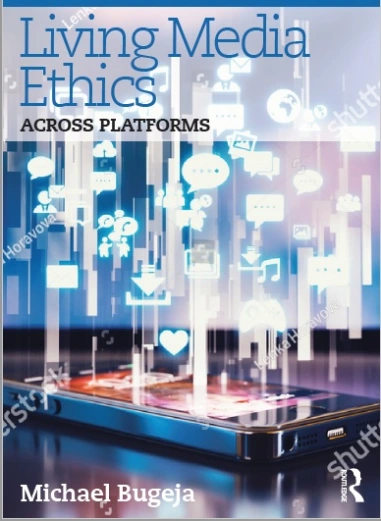
Living Media Ethics: across platforms, winner of the Clifford G. Christians Award for Research in Media Ethics, is a substantially updated text forthcoming from Routledge/Taylor & Francis. It differs from other similar texts in that it focuses on issues associated with moral (rather than technological) convergence. It posits that moral convergence is essential to address the complex issues of our high-tech media environment. As such the book departs from and yet complements traditional pedagogy.
Technological training is essential in the global media age. But that training must be tempered with ethical principles in as much as these powerful tools allow worldwide access anywhere at any time to a diverse audience in multiple cultures. In such a non-stop digital environment, students need to cease on occasion looking “out there” for news, photographs and clients. Rather, they must remember to pause and search “in here,” the conscience, for directions on how to serve the audience, maintain standards and act ethically as a professional.
Content covers all areas of media, including advertising, journalism (newspapers, magazines, photojournalism, broadcast journalism, digital, etc.) and public relations. Use of social media and multimedia is included in each of these media disciplines.
This approach also distinguishes the work from other texts in the genre. With the focus on motive and moral convergence, Living Media Ethics levels the playing field by treating each media platform as equal partner, particularly since content in the digital age is apt to affect all areas of media. Other texts single out “Advertising Ethics” or “Public Relations Ethics” as distinct from “Journalism Ethics.” Not so here. The benefit here is that students in one discipline are exposed to the standards of other communications industies. The focus throughout is on conscience, knowing right from wrong according to ethical tenets from the ancients to the current day. Philosophy and history are subtexts to each chapter so that students learn a moral, secular base that prizes the First Amendment and the Bill of Rights.
Living Media Ethics familiarizes learners with basic ethical concepts from which they can derive answers to seemingly complex questions. Examples:
- Conscience: The conscience is associated with ethics—an intuitive knowledge of right and wrong—involving how we choose to live among and view others in a diverse community.
- Consciousness: Consciousness is associated with awareness—how our interactions affect or influence others and ourselves in that diverse community.
- Conscience and consciousness: Both must harmonize and inform each other for us to feel grounded, whole. Each chapter pivots on conscience and consciousness, portals of emotional intelligence through which students feel values rather than just explicate or memorize them.
Outstanding Features:
Living Ethics employs an applied ethics pedagogy, associating abstract values with concrete situations across media platforms. The book has three sections: Influence, Responsibility, Truth to develop ethical awareness; Falsehood, Bias, Manipulation, Temptation to test ethical values; Fairness, Discretion, Power to enhance ethical values. A bevy of philosophical theories and historical facts introduce other moral tenets, including grace, compassion, forgiveness, mindfulness and other human expressions that the best journalists and practitioners recognize, not only in themselves, but in their sources and clients.
Each chapter helps students assemble a personal ethics code included in online portfolios so that they have a concrete symbol by which to live their values and secure internships and employment.
Students living their ethics possess the ability to:
- Distinguish between good and bad, outcomes over which we have little control, versus right and wrong, choices over which we have much control.
- Foresee short-term and long-term consequences before making choices.
- Accept responsibilities for their choices, no matter if the outcome is good or bad.
- See the world as it actually is rather than through personal filters of self-interest, ego or fear.
- Develop conscience and consciousness so that they work as effortlessly as hand-eye coordination.
- Be sensitive to others’ viewpoints and their own emotions so that they can learn from others and be more aware of motives, including their own.
- Apply only as much power as needed to resolve a challenge without creating greater problems or harm to innocent others.
Living Media Ethics seeks to: (a) evoke emotional intelligence associated with conscience and consciousness, so that students feel as well as know their values; (b) spark discussions from a morally informed perspective; and (c) encourage students to develop values in the work place by assembling online portfolios with personal ethics codes as “living documents.”
At the end of each chapter the book contains a personal and group/instructor ethics/journal exercise that encourages blogging and discussion. Click here for a sample.